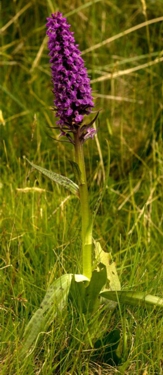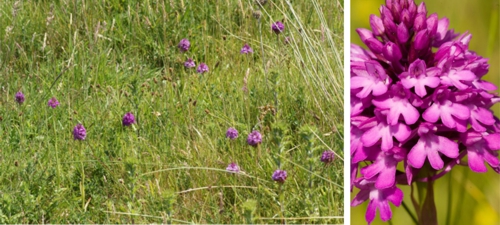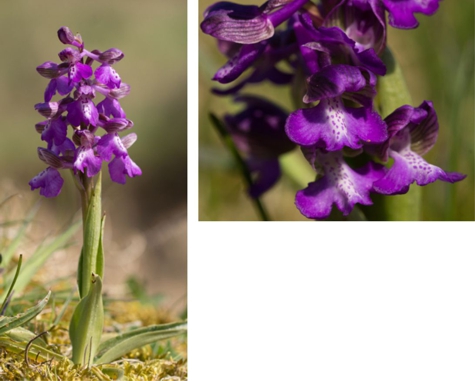Northern Marsh-orchid Dactylorhiza pupurella … Tegeirian y Fign
June – July
Identification: 10 – 30cm. In Wales, this orchid is somewhat smaller than most of the Marsh orchids. The distinctive bright red-purple flowers have a diamond-shaped, or slightly rounded, lip which is unlobed. They are borne tightly on an inflorescence which is often flattened at the apex. The leaves are generally unspotted or lightly so.
Similar species: The Southern Marsh-orchid, with which it often co-habits, is usually a more robust with a large rounded lip. The flowers of this species generally have a pinker colouration although some populations, especially on sand dunes, may be distinctly purple
Habitat: In Wales this is a species almost exclusively of sand dunes.
Distribution: Found in large populations in North Wales but also in smaller numbers on coastal dunes in the south.
Conservation issues: None
Notes: In some dunes to the north of the country, such as Ynyslas, abundant numbers of this orchid are a wonderful sight in June.

…………………………………………………
Welsh Northern Marsh-orchid Dactylorhiza pupurella var. cambrensis … Tegeirian y Fign Cymreig
This taxon is not recognized by all authorities, but appears on the Kew Moncot Checklist.
Early June – Early July
Identification: 15 – 30cm. A rather more robust plant than var. pupurella. The inflorescence is also larger and made up of tightly packed, rather paler flowers. Again, these tend to be larger with more prominent lobes to the lip. The leaves are almost always spotted, sometimes heavily so.
Similar species: Invariably grows with var. pupurella but can usually be distinguished from it by the features described above. In my experience it also usually flowers somewhat earlier.
Habitat: A species that grows exclusively in dunes slacks.
Distribution: Found in small numbers on some dunes in Cardiganshire and Anglesey.
Conservation issues: Populations appear to be stable, although the one at Ynyslas has always been vulnerable to local pressures.
Notes: This orchid has been the subject of much discussion since it was first described by the Welsh botanist R.H.Roberts in 1961, and has undergone a number of name changes. The nomenclature used here is based on the results of DNA analysis by Professor Richard Bateman. This work suggests that it warrants varietal status and indeed may be a hybrid. It is our only endemic Welsh orchid.

…………………………………………………
Pyramidal Orchid Anacamptis pyramidalis … Tegeirian Bera
June – Early August
Identification: 15 – 40cm. The inflorescence is triangular in shape but is rounded when all the flowers are out, and carried prominently atop a long leafless stalk. The flowers are a uniform red-pink colour with a deeply-lobed lip.
Similar species: The colouration of the flowers is similar to that of the Fragrant-orchids. The inflorescence is shorter and broader. In addition the lip of this species is much more deeply cut.
Habitat: Has a preference for calcium rich soils which in Wales is largely coastal sand dunes.
Distribution: Restricted to the coasts, particularly in the north and south, but at these it may be abundant.
Conservation issues: None

…………………………………………………
Green-winged Orchid Anacamptis morio … Tegeirian y Waun
April – May
Identification: 5 – 20cm. The squat inflorescence is crowded with largish usually dark purple flowers with pronounced greenish sepals marked with parallel green veins. The colour is variable, including pink and in most large populations small albino flowers will be found. The leaves are almost always unspotted.
Similar species: The Early Purple Orchid flowers at about the same time. See notes on this species.
Habitat: Usually non acidic grasslands, including sand dunes, where the grass is short enough not to obscure the leaves.
Distribution: Confined mainly to coastal areas of Wales and absent from large areas in the interior of the country.
Conservation issues: This orchid was once abundant in the Vale of Glamorgan but changes in agricultural practices have decimated these populations. In this area it is now restricted to coastal dunes.
Notes: Until fairly recently this orchid was in the genus Orchis with The Early Purple Orchid. But DNA analysis has indicated that it is related to the Pyramidal Orchid, Anacamptis pyramidalis.

…………………………………………………
Fly Orchid Ophrys insectifera … Tegeirian Pryfyn
May – June
Identification: 10 – 20cm. The small brown and green flowers atop the slender green stem are distinctive and also very hard to spot.
Similar species: None
Habitat: In grassy areas occurring with low-growing vegetation.
Distribution: Found only on the calcareous bogs of central but recently found in Denbighshire.
Conservation issues: Very rare although thanks to careful management where it is found numbers are stable.
Notes: Unlike the Bee Orchid, finding plants of this species can be surprisingly difficult.
…………………………………………………..
Bee Orchid Ophrys apifera… Tegeirian y Gwenyn
June – July
Identification: 10 – 25cm. A distinctive species. The inflorescence arises from a few grass-like leaves and caries a variable number of prominent flowers. These consist of three attractive pink sepals surrounding a striking lip which is largely brown with yellow markings.
Similar species: The only similar species is the Fly Orchid which is very rare in Wales and not likely to be confused with the Bee Orchid.
Habitat: Generally in open grassy areas in conjunction with other meadow flowers. But is also founds on dunes and very occasionally heavily shaded woodlands where the flower spikes are rather lank.
Distribution: The counties along the north and south coasts but absent from large areas in the centre of the country.
Conservation issues: None and numbers may be increasing.
Notes: A number of variations in the lip of the species have been described. These opportunistic sports may be found in any population.
Although the lip of the flower has probably evolved to attract male insects to effect pollination as other members of the genus, the Bee Orchid is invariably self-pollinated.

…………………………………………………